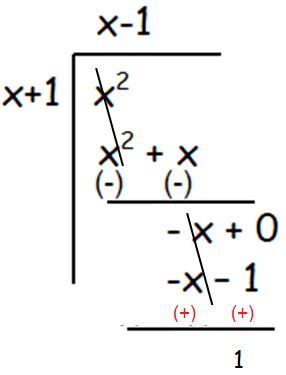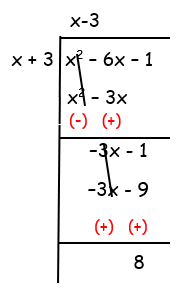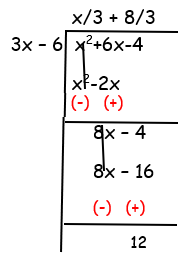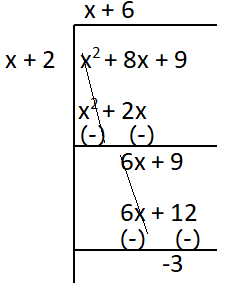HOW TO FIND ASYMPTOTES OF A RATIONAL FUNCTION
Subscribe to our ▶️ YouTube channel 🔴 for the latest videos, updates, and tips.
An asymptote for the curve y = f(x) is a straight line which is a tangent at ∞ to the curve. In other wards the distance between the curve and the straight line tends to zero when the points on the curve approach infinity. There are three types of asymptotes. They are
(i) Horizontal Asymptote
(ii) Vertical asymptote
(iii) Slant asymptote
Horizontal asymptote :
It is parallel to the x-axis. The line y = L is said to be a horizontal asymptote for the curve y = f(x) if either
lim x -> +∞ f(x) = L or lim x -> -∞ f(x) = L
Vertical asymptote:
It is parallel to y-axis. The line x = a is said to be a vertical asymptote for the curve y = f(x), if
lim x -> a- f(x) = ± ∞
or lim x ->a+ f(x) = ±∞
Slant Asymptote :
A slant (oblique) asymptote occurs when the polynomial in the numerator is a higher degree than the polynomial in the denominator.
To find the slant asymptote you must divide the numerator by the denominator using either long division or synthetic division.
How to find Horizontal, Vertical and Slant Asymptote
How to find horizontal asymptote ?
1) If
degree of numerator > degree of denominator
then the graph of y = f(x) will have no horizontal asymptote.
2) If
degree of numerator = degree of denominator
then the graph of y = f(x) will have a horizontal asymptote at
y = leading coefficient of numerator/leading coefficient of denominator
3) If
degree of numerator < degree of denominator
then the graph of y = f(x) will have a horizontal asymptote at y = 0 (i.e., the x-axis).
How to find vertical asymptote ?
The graph of y = f(x) will have vertical asymptotes at those values of x for which the denominator is equal to zero.
How to find slant asymptote ?
To find the slant asymptote you must divide the numerator by the denominator using either long division or synthetic division.
Find the asymptotes of the following curves :
Problem 1 :
f(x) = x2/(x2 - 1)
Solution :
Horizontal asymptote :
Horizontal asymptote is = 1/1
y = 1
Vertical asymptote :
x2-1 = 0
x2 = 1
x = ±1
There is no slant asymptote.
Problem 2 :
x2/(x + 1)
Solution :
Horizontal asymptote :
Degree of numerator > degree of denominator
So, there is no horizontal asymptote.
Vertical asymptote :
x + 1 = 0
x = -1
Slant asymptote :

So, the slant asymptote is y = x - 1.
Problem 3 :
f(x) = 3x/√(x2 + 2)
Solution :
Horizontal asymptote :
Degree of numerator = degree of denominator
Horizontal asymptotes are = 3/1 and 3/-1
So, horizontal asymptotes are 3 and -3
Vertical asymptote :
√(x2+2) = 0
x2 = -2
No real values for x.
There is no slant asymptotes.
Problem 4 :
f(x) = (x2 - 6x - 1)/(x + 3)
Solution :
Since degree of numerator is greater than the denominator, there is no horizontal asymptote.
x + 3 = 0.
x = -3
So, vertical asymptote is x = -3.
Slant asymptote :

Slant asymptote is y = x - 3.
Problem 5 :
f(x) = x2 + 6x - 4/(3x - 6)
Solution :
Since the numerator is having highest exponent, there is no horizontal asymptote.
3x-6 = 0
x = 2
So, vertical asymptote is x = 2
Slant asymptote :

Slant asymptote is y = x/3 + 8/3.
Problem 6 :
Find the horizontal and vertical asymptotes of the rational function
f(x) = (x + 11) / (x2 - 25x)
Solution :
f(x) = (x + 11) / (x2 - 25x)
Horizontal asymptote :
f(x) = (x + 11) / x(x - 25)
The highest exponent of the denominator is greater than the highest exponent of the numerator. Then it has horizontal asymptote as y = 0.
Vertical asymptote :
To find the vertical asymptote, we have to equate the denominator to 0.
x(x - 25) = 0
x = 0 and x = 25
Problem 7 :
Find the horizontal and vertical asymptotes of the rational function
f(x) = -3x2 / (x2 + 7x - 44)
Solution :
f(x) = -3x2 / (x2 + 7x - 44)
Horizontal asymptote :
Since both numerator and denominator has same power the horizontal asymptote will be
y = leading coefficient of numerator / leading coefficient of denominator
y = -3/1
y = -3
Vertical asymptote :
x2 + 7x - 44 = 0
x2 + 11x - 4x - 44 = 0
x(x + 11) - 4(x + 11) = 0
(x + 11)(x - 4) = 0
x = -11 and x = 4
So, vertical asymptotes are x = -11 and x = 4.
Problem 8 :
Give the equation of the oblique asymptote, if any, of the function.
f(x) = (x2 + 8x + 9)/(x + 2)
Solution :
f(x) = (x2 + 8x + 9)/(x + 2)
Since the highest exponent of the numerator is greater than the highest exponent of the denominator, we will get only slant asymptote.

= (x + 6) - 3/(x + 2)
Equation of slant asymptote is y = x + 6
Subscribe to our ▶️ YouTube channel 🔴 for the latest videos, updates, and tips.
Kindly mail your feedback to v4formath@gmail.com
We always appreciate your feedback.
©All rights reserved. onlinemath4all.com
Recent Articles
-
10 Hard SAT Math Questions (Part - 38)
Dec 08, 25 12:12 AM
10 Hard SAT Math Questions (Part - 38) -
SAT Math Practice
Dec 05, 25 04:04 AM
SAT Math Practice - Different Topics - Concept - Formulas - Example problems with step by step explanation -
10 Hard SAT Math Questions (Part - 37)
Dec 03, 25 07:02 AM
10 Hard SAT Math Questions (Part - 37)


